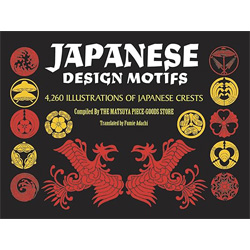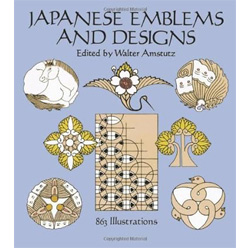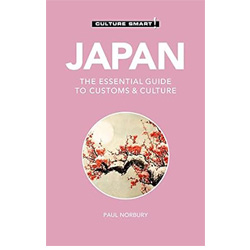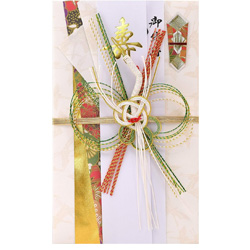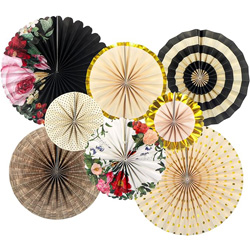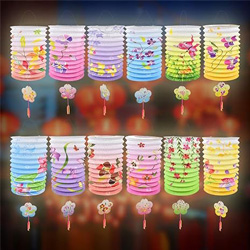- Jewelry
- Inspiration
- Our imagination
- Birthstones
- Celebrating with Eternal Flowers
- Druids and druidesses
- Flower meanings
- History, archeology jewelry
- History and healing properties of metals
- History and healing properties of stone
- Illumination jewelry
- Japanese symbols
- Maya calendar jewelry
- Stone color symbolism
- Stones catalogue
- Wedding anniversaries
- Searches a theme on the site
- Good Deals
- Paintings
- About
- Contact
JEWELRY
- Anklet
- Bracelets
- Brooches
- Cufflinks
- Earrings
- Pendants & Necklaces
- Rings
- Draw your jewelry
- How to clean your jewel
- Metal we used
INSPIRATION
- Our imagination
- Birthstones
- Celebrating with Eternal Flowers
- Druids and druidesses
- Flower meanings
- History, archeology jewelry
- History and healing properties of metals
- History and healing properties stones
- Illumination jewelry
- Japanese symbols
- Maya calendar jewelry
- Stone color symbolism
- Stones Catalogue
- Wedding anniversaries
- Searches a theme on the site
Japanese symbols and jewelry
Japanese culture, deeply rooted in a rich and complex history, inspires a multitude of symbols that are reflected in the art of jewelry. When one thinks of Japan, they are immediately transported to a world where the beauty of cherry blossoms, a symbol of fleeting love and the fragility of life, intertwines with the legend of the courageous samurai, guardians of honor and tradition.
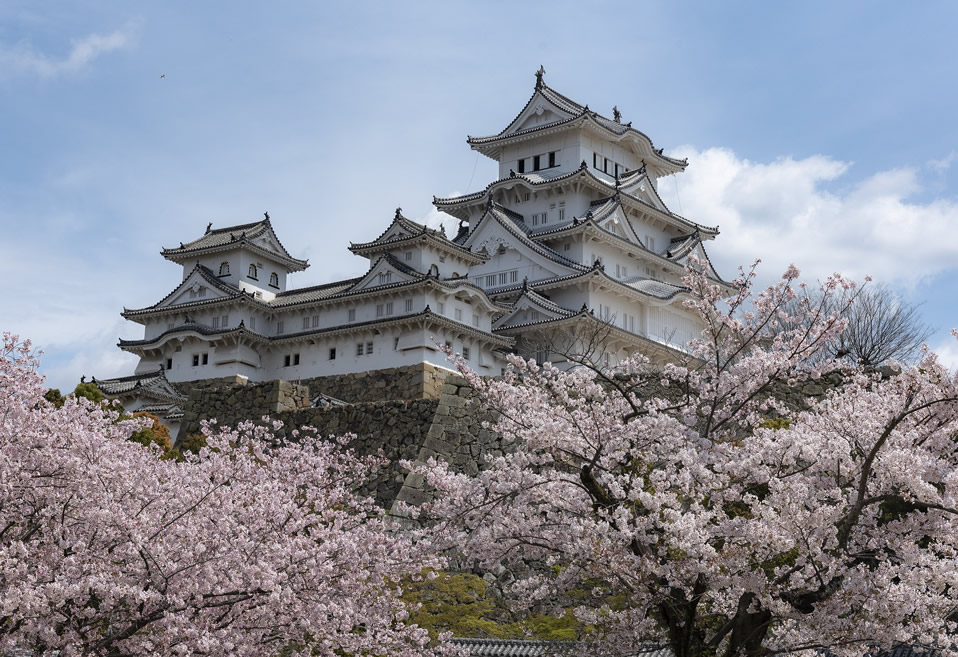
When one thinks of Japan, they are immediately transported to a world where the beauty of cherry blossoms, a symbol of fleeting love and the fragility of life, merges with the legend of the courageous samurai, guardians of honor and tradition. It is also a country where the discipline of martial arts, a millennia-old heritage, is intertwined with textile elegance, embodied by the kimono, a true work of art worn with grace and reverence. But Japan is also a culture where rituals shape daily life, from the tea ceremony, a genuine art of living, to the deep respect for nature, inherited from Taoism, which permeates every action and thought.
We have sought to capture the essence of Japan through our rings, earrings, and necklaces, especially to reflect the theme of the Japanese wedding.
Cherry blossom jewelry
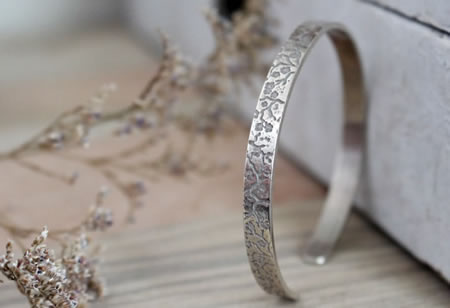
Cherry trees, emblems of fleeting beauty and delicacy, form one of the most iconic images of Japan. When these majestic trees are adorned with their delicate blossoms, the entire country transforms into a breathtaking canvas, draped in a pale pink mantle that evokes the gentle arrival of spring. Cherry blossoms, known as Sakura, are deeply rooted in the Japanese imagination, symbolizing the transience of life and the beauty of the present moment.
The spectacular blooming of the Japanese cherry tree, which I was fortunate enough to witness a few years ago, is celebrated during Hanami ("flower viewing"), a centuries-old tradition that invites the Japanese to contemplate and celebrate the ephemeral beauty of the cherry blossoms. It is a time of joy and togetherness, where families and friends gather for picnics under the blooming trees, sharing stories and laughter as the pink petals gently fall. The blooming is also a moment for meditation and reflection, allowing everyone to reconnect with nature and contemplate the passage of time.
The cherry blossoms’ bloom, eagerly anticipated each year, typically occurs between late March and early April, but its duration is fleeting, lasting only about two weeks. During this period, the whole of Japan seems to pause to admire the delicate beauty of these transient flowers. This short bloom symbolizes the fragility and fleeting beauty of life, reminding us all to seize the moment.
Like many, I carry the image of those pink flower petals carried by the wind, an image that evokes the romance and poetry of the Japanese spring. It is a vision that remains etched in memory, a reminder of the fleeting beauty and magic of Hanami. The cherry blossom is also often depicted in traditional Japanese art, from ukiyo-e prints to ceramics, underscoring its cultural and aesthetic significance.
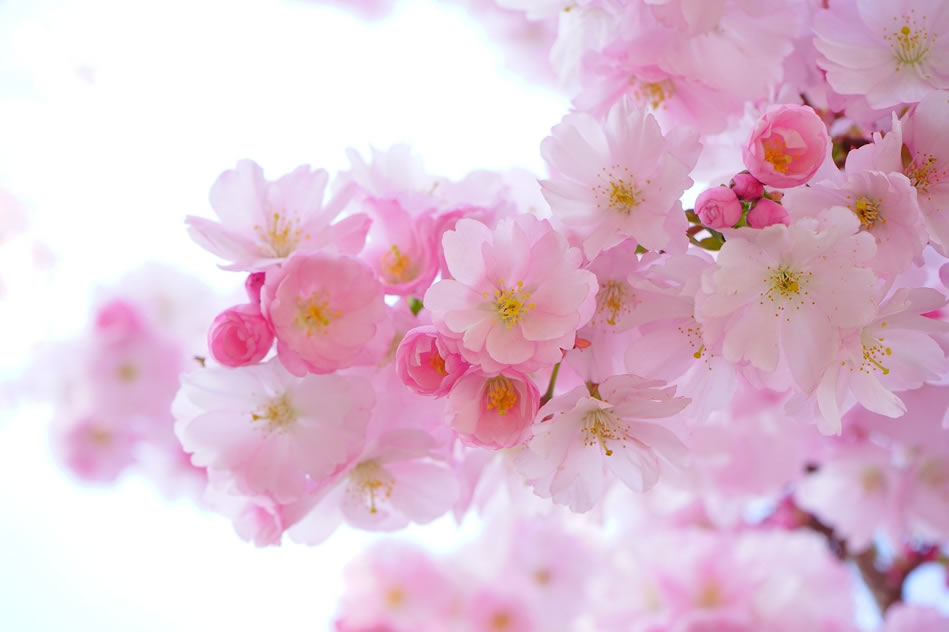
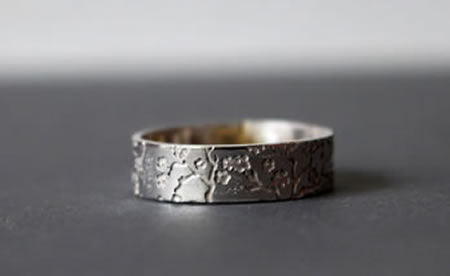
The cherry blossom, or Sakura, is much more than just a tree or a flower in Japanese culture. It is a deeply rooted symbol in the collective imagination, evoking the fleeting beauty and fragility of life. With its brief lifespan, the cherry blossom serves as a powerful metaphor for the transient nature of human existence. It also symbolizes renewal, success, and growth, reminding us that each season brings its own changes and new opportunities.
The blooming of cherry blossoms, marking the arrival of spring, is a time of celebration and hope for the Japanese. It signals the beginning of a new season of abundance and growth, as nature awakens after winter and the flowers burst into life. This period is also associated with festivals and cultural events that celebrate the start of spring, reinforcing the connection between the Japanese people and their natural environment.
We have chosen to incorporate this iconic cherry blossom motif into various pieces of jewelry, including rings, earrings, and a bracelet. These pieces are not only elegant accessories but also carry the deep meaning of the cherry blossom, reminding those who wear them of life’s fleeting beauty and the importance of embracing each moment with gratitude and wonder. Whether for a Japanese wedding or simply to express your love for Japanese culture, these jewelry pieces are a tribute to the richness and depth of this ancient tradition. Each piece captures the essence of Hanami, offering a tangible connection to Japanese culture and its celebration of ephemeral beauty and renewal.
The crane in Japan
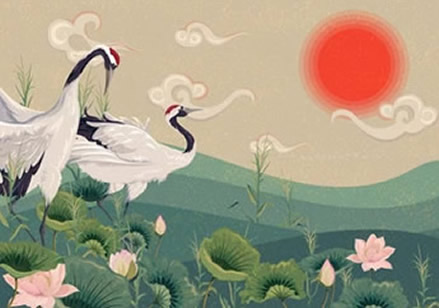
The crane, a majestic and graceful bird, holds a prominent place in Japanese culture, deserving special attention in jewelry design.
As a revered symbol, the crane is ubiquitous in Japanese art, appearing in prints, fabrics, and engravings. It is often depicted in flight, embodying freedom and elegance, or in a resting posture, symbolizing peace and serenity. This bird is also a common decorative element in Japanese homes, whether in the form of a statue or delicate origami.
Standing at an impressive 1.5 meters tall with a wingspan that can reach 2.5 meters and weighing around 10 kilograms, the crane symbolizes longevity, happiness, and good fortune in Japanese culture. According to legend, the crane is said to live for 1,000 years and is believed to carry souls to paradise, making it a symbol of protection and benevolence.
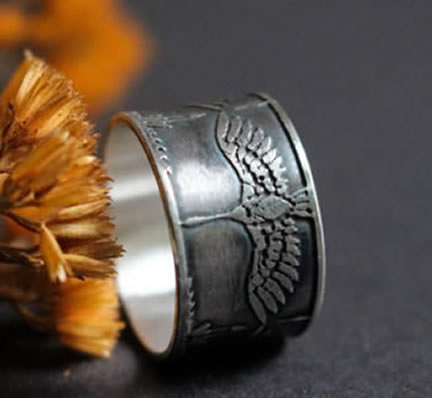
In addition to its association with longevity, the crane is also a symbol of fidelity and commitment in Japanese culture. It is said that this bird chooses a single partner for life, making it a representation of enduring love and loyalty. This connection is especially evident in wedding kimonos, such as the uchikake, where the crane is embroidered to symbolize eternal union and faithful love.
To honor this powerful symbolism, we have created a ring called "The Legend of a Thousand Cranes," or *Senbazaru*. This Japanese myth tells the story that folding 1,000 origami cranes grants a wish related to longevity, health, or happiness, further strengthening the connection between the crane and these essential values. According to the legend, achieving this feat requires remarkable perseverance and determination, qualities we have aimed to capture in each piece of our collection.
Each "Legend of the Thousand Cranes" ring is a tribute to the beauty and symbolic richness of this iconic bird. It invites belief in the magic of Japanese traditions and encourages the pursuit of dreams with determination and hope, just as folding 1,000 cranes is believed to grant a heartfelt wish. This piece is not only an elegant piece of jewelry but also a powerful symbol of Japanese culture, representing fidelity, longevity, and good fortune.
The Japanese fan
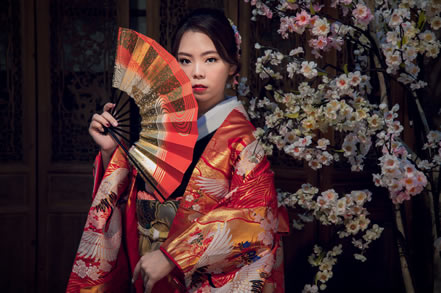
The fan embodies an image of femininity and sensuality, characteristics that are also prevalent in Japanese culture, where it is often finely decorated. It is an accessory inseparable from the geisha, symbolizing her legendary elegance and refinement.
The earliest traces of the Japanese fan date back to the 6th century AD, discovered in mural paintings from a tomb in Fukuoka. Since then, this accessory has evolved to become an iconic element of Japanese culture, embodying both tradition and contemporary elegance.
Traditionally, there are two types of fans: the *uchiwa*, which is oval, round, or square in shape with a fixed handle, and the *sensu* or *ôgi*, a folding fan invented in the 7th century. According to legend, the concept of the *sensu* was inspired by a peasant who observed the wings of bats.
Each fan, whether *uchiwa* or *sensu*, is a work of art in itself, often adorned with delicate motifs and vibrant colors, reflecting the richness of Japanese tradition and aesthetics. Designs can include symbols such as plum blossoms, representing perseverance, or stylized waves, symbolizing fluidity and eternity. These decorations are not merely ornamental; they carry deep meanings and wishes for good fortune, longevity, and prosperity. Whether used to cool oneself on a hot day or to add a touch of elegance to an outfit, the fan remains an enduring symbol of Japanese grace and sophistication.
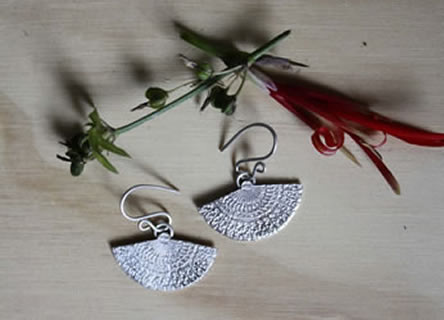
The fan holds a prominent place in Japanese culture, both in everyday life and in traditional ceremonies, such as the famous tea ceremony. In this ceremony, the fan is used to indicate the water temperature and add a touch of elegance to the ritual. It is also surprising to note that this accessory, often associated with grace and beauty, was once used as a weapon. Folding fans could be concealed to serve as shields or aids in martial arts practice.
Invented in Japan, the fan was exported to Europe via China, where it quickly won the hearts of aristocrats and elites, becoming a symbol of status and refinement.
In our creations, you will find a version of the Japanese fan in a pair of engraved silver earrings, named Han’i. This piece of jewelry features the shape of the folding fan, adorned with subtle designs representing traditional motifs. It is a tribute to the beauty and grace of this iconic accessory, while incorporating the rich symbolism and aesthetic of the Japanese fan into modern design.
Koi: the Japanese fish
Japan is also renowned for its stunning gardens, where the harmony between man and nature is celebrated. The green spaces of Japanese homes are always meticulously organized, providing a haven of peace and tranquility. At the heart of these gardens, you often find a pond, where another iconic animal of Japan, the koi fish, majestically resides.
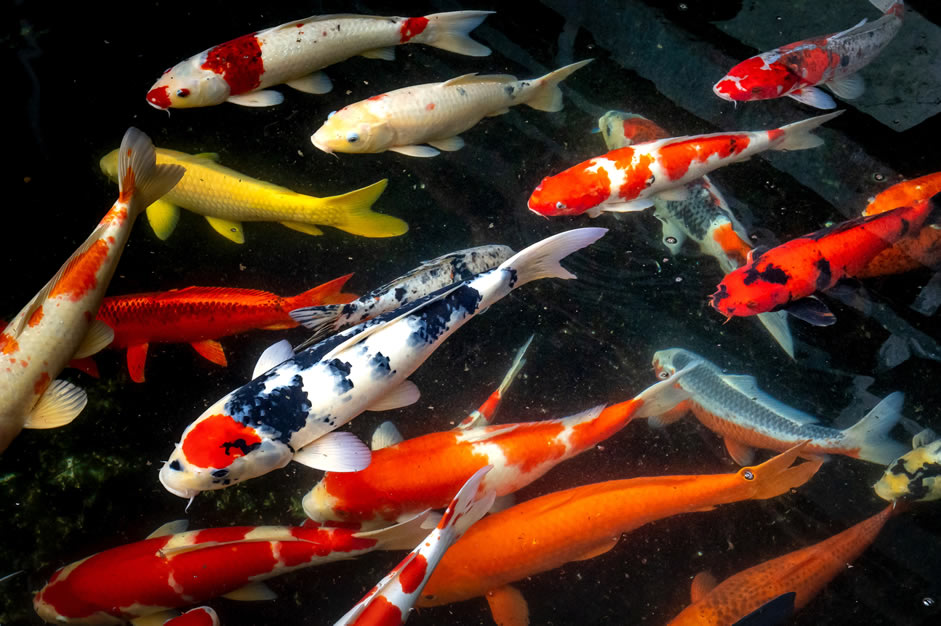
The koi fish, or brocade carp, is a freshwater fish native to Asia that originally lived in rice paddies. It is a highly prized ornamental fish known for its vibrant color combinations, ranging from red and white to yellow and black, which give it a unique beauty and unmatched elegance. The koi is also renowned for its calm and peaceful nature, making it an ideal companion for those seeking tranquility and serenity in their surroundings.
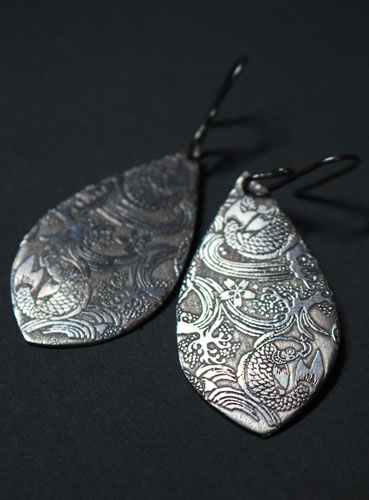
The koi fish holds a prominent place in Japanese culture, far beyond the ponds where it is often raised. It is frequently depicted in art, including prints, paintings, textiles, fans, and other craft objects.
The earliest references to koi date back to the 5th century BC when they were believed to have been brought to Niigata Province from breeding farms in China and Korea. Since then, this majestic fish has become a symbol of strength, perseverance, and success in Japanese culture.
Koi can grow up to 1 meter in length and weigh up to 15 kilograms. They have an average lifespan of around 20 years, but some can live up to 70 years, making them a long-term companion for those fortunate enough to keep them in their garden or pond.
The Japanese term for koi is "nishikigoi," meaning "colored fish," due to its beautiful colors and patterns.
These fish are primarily raised for ornamental purposes, particularly in the village of Yamakoshi, where they have become a symbol of pride and tradition. Originally, the koi was a black carp known as magoi. Through selective breeding in the rice paddies of Japan starting in the 1800s, the more colorful and ornamental koi gradually emerged. This selective breeding resulted in a variety of unique colors and patterns that have become distinctive features of the koi.
Japanese koi primarily symbolize strength, bravery, and perseverance, as demonstrated by their ability to swim upstream against strong currents and waterfalls in Japan. Additionally, koi also represent success, peace, serenity, love, and masculinity. In Japanese culture, koi are often associated with achievement and prosperity, making them symbols of luck and happiness. This is why tradition holds that koi-themed cards are given to students to wish them good luck during exams. This tradition dates back to the Edo period when students used these cards to encourage one another during examinations.
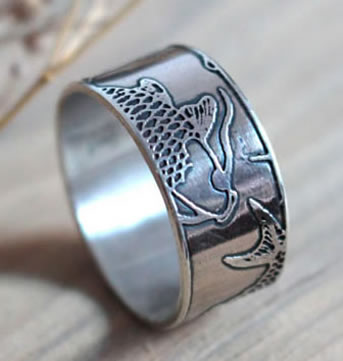
According to ancient legend, each year after the third moon, a fascinating spectacle unfolds along the Yellow River in Japan. Thousands of koi, driven by a mystical force, embark on an epic journey from the sea, braving tumultuous waters to swim upstream. Their ultimate destination is the mythical waterfall known as the "Dragon’s Gate," where only the bravest can hope to reach the top. In this heroic struggle against the fierce current, koi demonstrate unwavering courage, overcoming marine predators, the nets of greedy fishermen, and the numerous dangers along their path. Only those selected are able to surmount all obstacles and reach the summit of the waterfall, where a miracle occurs: these humble fish transform into majestic golden-scaled dragons, symbols of power and wisdom in Japanese culture, and soar into the sky. This ancient legend, passed down through generations, is thought to explain the origin of the carp-shaped kites that children fly in the Japanese sky. Every time a kite takes flight, it is a tribute to the strength and determination of the koi and a reminder of the possibility of transcending challenges to reach new heights.
In our store, we offer various representations of the koi, providing a range of options for those wishing to celebrate the powerful symbolism of this iconic creature in Japanese culture. Among our creations, you will find rings, wedding bands for a Japanese wedding signifying success, earrings, and pendants, each adorned with subtle and elegant koi motifs. These pieces not only honor the physical beauty of the koi but also its profound symbolism in Japanese culture, embodying the values of perseverance, success, and transformation.
The Japanese sea: wave jewelry
Japan, an island nation bordered by the Pacific Ocean, is deeply connected to the sea and ocean, which play a vital role in the country’s culture and identity. The sea and ocean are a crucial source of food for Japan, providing an abundance of fish and seafood that are central to Japanese cuisine.
In Japanese, the sea and ocean are referred to by a single word, "umi," which evokes the vast expanse of water surrounding the Japanese archipelago. In Japanese culture, water and waves are often associated with power and resilience, symbolizing the strength and determination required to navigate the tumultuous waters of life.
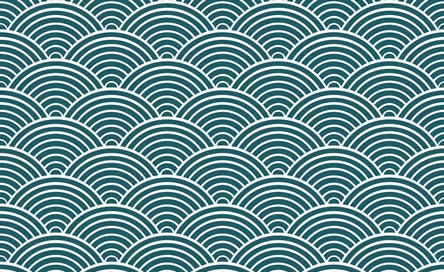
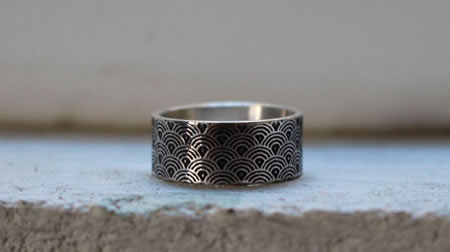
We have chosen to focus on two iconic representations of the sea, which are among the most famous and cherished motifs in Japanese culture. We have selected the calm sea depicted in the motif called Seigaiha, and the turbulent sea portrayed in a distinctly Japanese style.
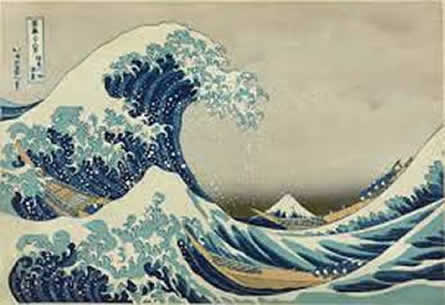
The first is the Seigaiha motif, also known as the "blue sea wave." This design consists of overlapping concentric circles, creating the appearance of gentle and regular waves. The motif resembles a series of small rainbows in the form of waves, evoking the tranquility and beauty of a calm sea.
This motif has a long history in Japanese culture. It first appeared in Japan in the 6th century and has since become a popular design on kimonos, ceramics, textiles, and other craft items. Additionally, it is associated with protection against misfortune and prosperity. The Seigaiha was also used on ancient Chinese maps to represent seas and oceans, highlighting its cultural significance beyond Japan. This repetitive pattern symbolizes the calm sea, peace, quiet strength, and good fortune, evoking the serenity and stability of the sea, as well as the tranquility and prosperity that come with it.
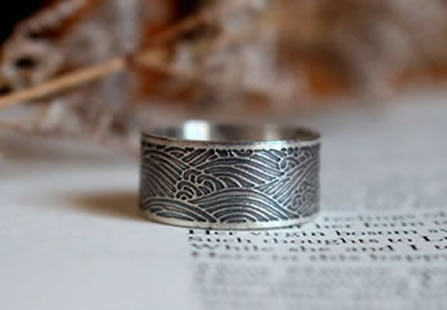
The second depiction of the sea is that of the storm, where the elements unleash their fury and the sea displays its full power. This representation is illustrated by the famous ukiyo-e print, "The Great Wave off Kanagawa," created by the master Hokusai. This iconic work captures the indomitable force of nature, where an immense wave threatens to crash down upon modest boats, contrasting the fragility of humanity against the grandeur and power of the marine elements. "The Great Wave off Kanagawa" is one of the most recognized and influential prints in Japanese art, representing the sublime and unpredictable power of nature.
This iconic image of the sea storm inspires deep reflection on the relationship between humanity and nature, emphasizing human humility in the face of the ocean’s devastating force. It serves as a reminder of nature’s wild beauty and the importance of respecting the mighty natural forces.
We have featured these marine motifs across various products in our store, offering a range of options for those who wish to celebrate the beauty and symbolism of the Japanese sea. Among our creations, you will find jewelry inspired by the Seigaiha motif and the sea storm, including rings, pendants, and bracelets. Each piece is designed to capture the essence of these iconic motifs, blending aesthetic appeal with profound meaning for those seeking to wear a symbol of the ocean’s power and serenity.
Origami jewel: geometry and rigor
What would Japan be without origami? This fascinating art, which requires patience and skill, is deeply rooted in Japanese culture. Origami, the art of paper folding, is an ancient practice that is believed to have originated in China during the Western Han dynasty (-202, -9). It is said to have been introduced to Japan by Buddhist monks, where it quickly developed around 1200 A.C. through Buddhist rituals. At that time, paper was rare and precious, and paper folding was primarily reserved for ceremonies, particularly for table decorations.
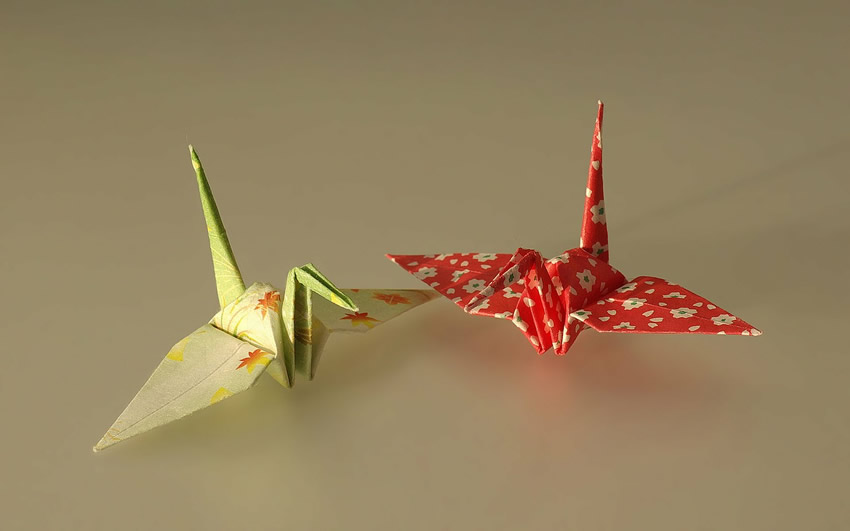
Origami is an art that requires patience and skill, and it has become a symbol of Japanese culture, representing beauty and simplicity. The Japanese have refined this technique over the centuries, creating complex and elegant folding patterns that have become works of art in their own right. Today, origami is used in various fields, from art and decoration to science and engineering, and it continues to inspire and fascinate people around the world.
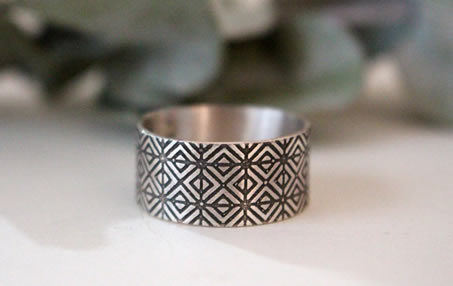
Origami is not limited to the creation of aesthetically pleasing shapes; it also holds deep cultural and symbolic significance. Origami figures, such as the crane (tsuru) or the lotus flower, often carry spiritual meanings. For example, folding 1,000 cranes in paper is a Japanese tradition known as Senbazuru, which is believed to grant a wish and is often associated with healing and peace.
In Japan, origami is also used in modern contexts such as engineering and architecture research. The principles of origami are applied to design innovative structures and foldable devices that are both functional and aesthetically pleasing.
To pay tribute to this Japanese art form, we have created a ring named origami. This piece is designed with a geometric pattern that evokes the folds and shapes created during the folding process before achieving the final origami result. The ring captures the essence of the folding technique, highlighting the complexity and precision required to create paper art. Each piece is meticulously crafted to reflect the beauty and rigor of origami, embodying the harmony between tradition and modernity.
This ring is a tribute to the patience, precision, and creativity that define the art of origami. It celebrates not only the beauty and simplicity of this practice but also the rich cultural and historical significance it represents. Wearing this ring is like carrying a piece of Japanese history and art, transformed into a contemporary jewelry creation.
The ginkgo biloba: a beautiful Japanese leaf for jewelry
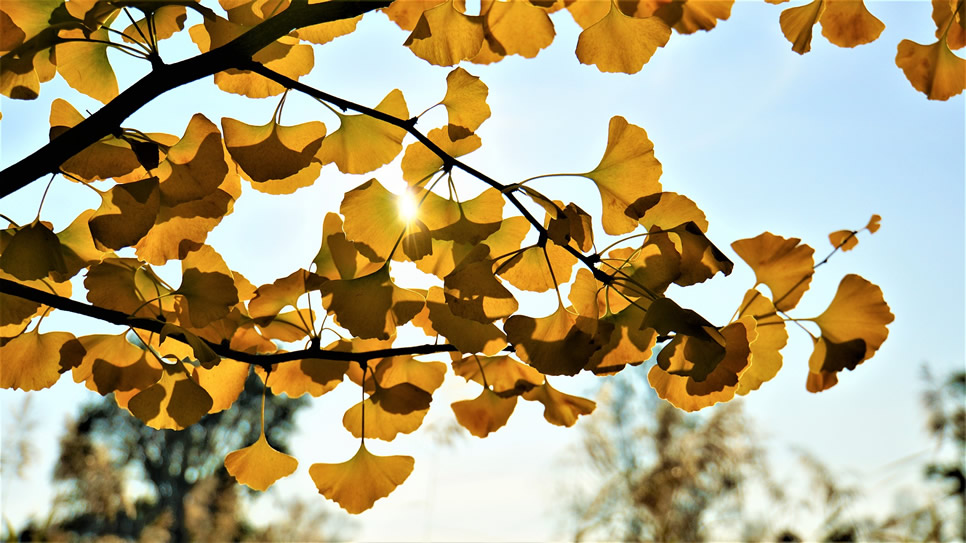
The leaf of the Ginkgo biloba tree is remarkably delicate with its fan-shaped form. You can find it featured in several of our creations. It also carries significant symbolism in Japan, often referred to as "the survivor."
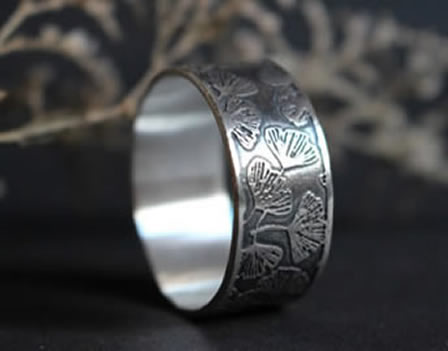
The Ginkgo biloba, also known as the "maidenhair tree" or "silver apricot tree," is a sacred tree whose fruit is called Ginnan in Japanese, and the tree itself is referred to as Icho. This tree boasts an extraordinary longevity, often estimated at over 3,000 years, and is distinguished by its unique fan-shaped leaves, which are split into two lobes.
Ginkgo species are believed to have appeared around 270 million years ago, during the Permian period, long before the age of dinosaurs. For this reason, it is sometimes referred to as a "living fossil." During the Quaternary glaciations, this species survived in southern China, where the climate was milder, while other ginkgo species became extinct.
Introduced to Japan and Korea around the 12th century, Ginkgo biloba has become a symbol of longevity, resilience, and strength. It is considered a "survivor" due to its ability to withstand numerous natural disasters and millennia of evolution. The tree is also associated with wisdom and knowledge, often planted near temples and shrines to bring luck and protection.
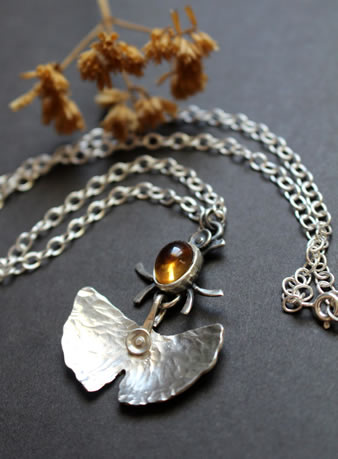
In addition to being the "survivor" among many plant species and its own species, Ginkgo biloba is an incredibly resilient, even indestructible tree. It is capable of enduring extreme conditions and natural disasters, making it a symbol of longevity and resilience.
Ginkgo biloba exhibits remarkable resistance, able to withstand extreme conditions such as pollution, frost, lightning, diseases, and pests. It can also thrive in polluted urban environments with low light, making it an ideal tree for cityscapes.
A notable example of the ginkgo’s resilience is the tree that survived the atomic bombing of Hiroshima on August 6, 1945. Located less than a kilometer from the blast site, this tree began to regrow and bloom again barely a year after the explosion, while all other plants in the vicinity had died. This ginkgo has become a powerful symbol of peace and resilience and is now revered as a national treasure in Japan.
In Japan, ginkgo nuts are used for various digestive issues, and since the 2000s, ginkgo is also employed to enhance cognitive functions in the elderly. Additionally, the ginkgo has been the official symbol of Tokyo since 1989.
Regarded as immortal due to its longevity and ancient lineage, with no natural predators, Ginkgo biloba represents much more than mere resistance to the elements. It embodies longevity, unity, invariability, growth, prosperity, charm, and tranquility. It is a tree revered for its ability to endure through the ages without losing its majesty.
Its leaves, with their unique two-lobed shape, symbolize more than just aesthetics. They represent duality, separation, reconciliation, and paradox. This duality reflects the multiple facets of life, where harmony can emerge from the coexistence of opposites. As such, Ginkgo biloba also becomes a symbol of love, where the complementarity of differences creates a harmonious and enduring strength.
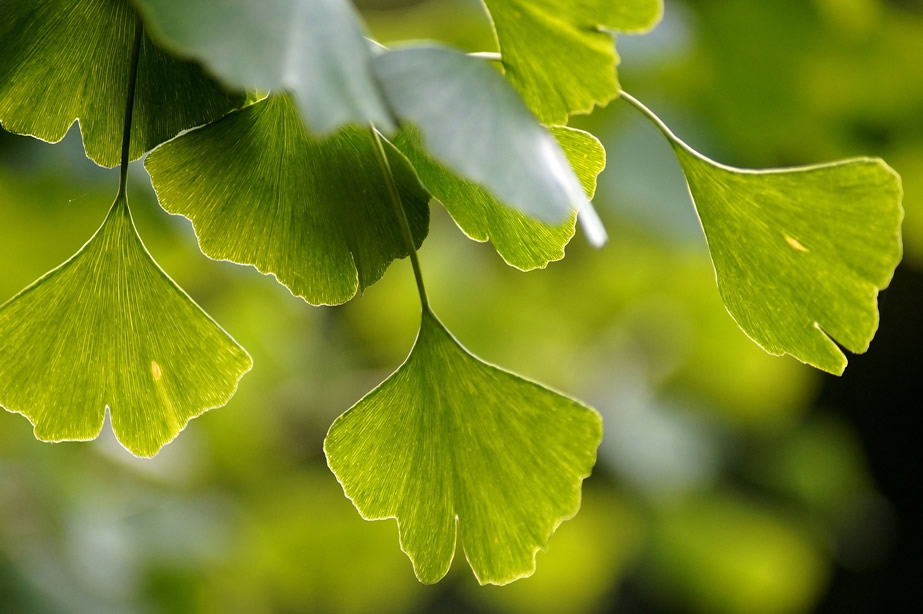
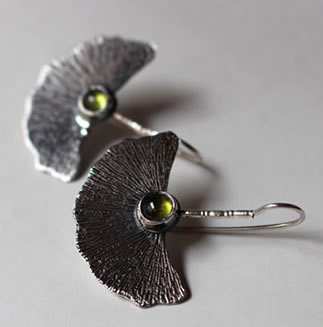
The ginkgo tree also holds deep significance related to motherhood. In the village of Awa, women who have given birth visit the birth god, represented in the form of a ginkgo tree, to pray and ask for an adequate supply of breast milk.
Over the years, the trunk of the ginkgo develops strange growths that resemble cow teats. These formations are called "Icho No Chichi," literally "the teats of the ginkgo." Breastfeeding women believe in their magical power and cut them to keep as talismans, hoping to increase their milk production.
This ancient practice reflects the deep connection between nature and daily life in Japan, where trees are revered for their healing and protective properties, and where folk beliefs blend harmoniously with modern life.
We have honored this Japanese symbol through a collection of exquisite rings, pendants, and earrings, capturing the essence of longevity and resilience symbolized by the Ginkgo biloba. These pieces are not merely elegant accessories but also expressions of love and connection, celebrating the meeting of two complementary souls, much like the two distinct lobes of the ginkgo leaf. By wearing these pieces, one carries with them the hope and promise of longevity, prosperity, and harmony in relationships, while also honoring the traditions and beliefs that have shaped Japanese culture for centuries.
Rice, a symbol in our jewelry

When thinking of Japan and its landscapes, one immediately envisions the terraced rice fields extending endlessly across the hills. These rice fields, with their perfect geometric lines and the shimmering reflections of water under the sun, symbolize the harmony between humans and nature. Cultivated for millennia, they have shaped not only the Japanese landscape but also its cultural identity.
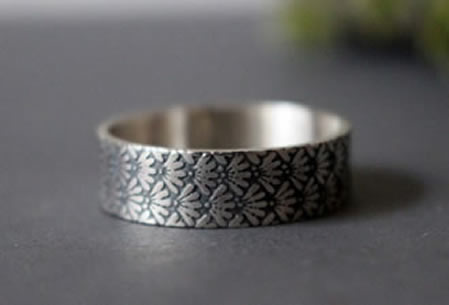
Originating from China, rice is believed to have been introduced to Japan around 3,000 years ago during the Jōmon period. It quickly became a staple food of the country, playing a central role in diet, economy, and rituals. Beyond its nutritional function, rice symbolized wealth and power in ancient Japanese society. During the feudal era, rice harvests were used to measure the wealth of a lord and were exchanged as a form of currency. Taxes paid to the government were calculated based on the amount of rice produced by the land, a system known as "kokudaka," where "koku" was the unit of measure representing the quantity of rice needed to feed one person for a year.
Although the economic value of rice has evolved over time with industrialization and diversification of diets, its symbolic significance remains intact. Rice continues to be regarded as a symbol of prosperity and purity. It is closely associated with religious rites and traditional celebrations. For instance, wedding ceremonies at Shinto shrines often include the sharing of sake, a rice-based alcohol, to symbolize the sacred union between the two spouses.
In Japanese spirituality, rice is also associated with Inari, the Shinto deity of fertility, rice, foxes, and abundance. Shrines dedicated to Inari are often adorned with statues of foxes, the deity’s messengers, and devotees offer rice to seek protection and prosperity.
Rice is also central to many agricultural festivals, including the harvest festival known as "Niiname-sai," where the emperor himself participates in a ceremony to thank the gods for good harvests and to celebrate the communion between humans and nature.
Despite a decline in rice consumption in modern Japan, partly due to the Westernization of eating habits, the white grain remains deeply embedded in Japanese culture. It is seen as a symbol of purity and vitality, not only due to its connection with nature but also because of the visual purity of the white grain growing in the crystal-clear waters of rice fields. This cycle of rice cultivation, from planting to harvest, embodies respect for natural cycles and the collective effort needed to achieve harmony.
To pay tribute to this ancient symbol, we have created the Ineko ring. Inspired by the simplicity and purity of the rice grain, this ring embodies the refined beauty and minimalist elegance characteristic of Japanese culture. Its flowing lines and delicate design echo the very essence of rice: a quiet strength and renewed vitality with each harvest. Just as rice nourishes both body and soul, this ring symbolizes life and renewal, celebrating the beauty and strength of nature. Wearing this ring carries a piece of the intimate connection between humans and the earth, honoring ancestral Japanese traditions and the perfect harmony between humanity and its environment.
Asanoha : a hemp leaf lucky charm
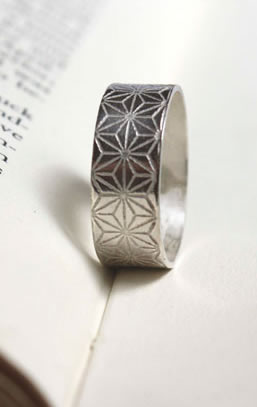
The geometric pattern known as Asanoha is a true treasure of Japanese antiquity, dating back to ancient times. The earliest traces of this pattern appear on Buddha sculptures from the Heian period (8th - 12th centuries), reflecting its long history and significance in Japanese culture. Used in art, architecture, and textiles, it has become a deeply ingrained symbol in Japan’s aesthetics and spiritual values.
Its name, "Asanoha," literally meaning "hemp leaves," reflects its botanical origin. Inspired by the hemp leaf, this pattern captures the beauty of nature while stylizing it with repetitive geometry. Hemp has always held a central place in Japanese traditions. Cultivated for its robust fibers, it was used to make clothing, ropes, and even talismans. Its natural resilience has become a metaphor for strength and growth, making it an auspicious symbol.
Visually, the Asanoha pattern is distinguished by a repetition of six-pointed stars formed by symmetrical diamonds. Each point is divided into triangles, evoking the perfection and regularity of the hemp leaf. This geometric symmetry is an abstract representation of nature that embodies purity, simplicity, and order. In Japanese thought, this pattern is also an allegory of rapid growth, as hemp is a plant that grows vigorously and unimpeded, symbolizing strength and resilience.
Hemp, with its associations of vigor, endurance, and prosperity, is often used in clothing for young children and newborns. Traditionally, mothers wrap their babies in swaddling clothes adorned with the Asanoha pattern, hoping that their children will grow up strong and healthy. The pattern is also found on kimonos, especially during important ceremonies or weddings, as it invokes prosperity, longevity, and protection against evil spirits.
The Asanoha pattern is also cherished for its connotations of prosperity. Wearing this pattern, whether in fashion accessories or jewelry, is often seen as a gesture of preparation for the future. It is particularly favored during moments of transition or new beginnings, such as a marriage or a birth, where the symbolism of growth and vitality is paramount.
Kikkô: under the sign of the turtle longevity
The kikkô, also known as Kikkoumon, is a geometric pattern featuring hexagonal shapes. When these hexagons are placed adjacent to each other, they form a design reminiscent of a honeycomb, with its cells creating a complex and harmonious structure.
This pattern dates back to medieval Japan and is inspired by the hexagonal shape of turtle shells. It is believed to have been used as early as the Heian period, between the 8th and 12th centuries, but it became particularly popular during the Edo period, between the 17th and 19th centuries. The kikkô pattern is found not only in Japanese crafts but also in temple architecture, where turtle motifs are carved into foundations to symbolize spiritual longevity and protection.
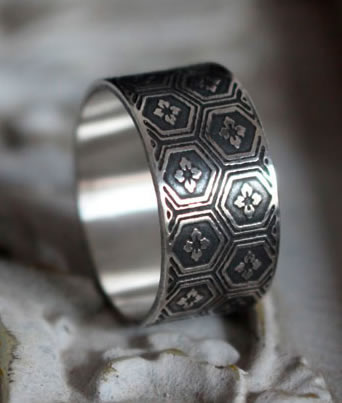
In Japanese tradition, the turtle is a symbol of good fortune. Its exceptional longevity makes it a symbol of both longevity and luck. The turtle is also associated with wisdom and perseverance, as it is viewed as an animal that takes its time to achieve its goals. By wearing patterns inspired by the turtle, one can invoke these qualities and benefit from their positive influence in life.
This connection with the turtle is also reflected in Japanese mythology through the figure of Minogame, a legendary turtle that lives for thousands of years and carries algae on its back. It symbolizes not only longevity but also protection and the connection between humans and nature. The divine turtle Genbu, one of the four guardian animals of Japan, also represents this idea of stability and protection, reinforcing the spiritual dimension of the kikkô pattern.
Thus, this pattern is found in Japanese weddings to place the ceremony under the auspices and longevity of the turtle. By symbolizing longevity, stability, and prosperity, the turtle motif is often incorporated into wedding ceremonies to wish the newlyweds a lasting and flourishing union. It serves as a constant reminder of the importance of patience, perseverance, and wisdom in building a solid and fulfilling relationship.
The kikkô pattern was also used in the making of samurai armor. These armors were composed of small hexagons of leather or metal sewn together, creating a strong yet flexible structure that offered maximum protection while allowing for great freedom of movement. This use of the kikkô pattern in samurai armor highlights its reputation as a symbol of protection and security, essential qualities for these legendary warriors.
In contemporary Japan, the kikkô pattern has evolved to find new life in fashion and design, particularly in accessories like jewelry and modern textiles. Today, this pattern symbolizes not only longevity and stability but also resilience in a constantly changing world. By incorporating these ancient motifs, modern creators honor a centuries-old tradition while integrating it into pieces that inspire and protect those who wear them, much like the samurai who once adorned their armor with this symbol.
There are several variations of the kikkô pattern, sometimes featuring additional motifs within the hexagon, such as flowers, circles, or diamonds. For example:
- The kikkô hanabishi shows the water chestnut flower also called water chestnut. This motif often appears as the coat of arms of samurai groups and symbolizes righteousness. The water chestnut flower, with its delicate petals and resilience in difficult environments, evokes the nobility and moral strength of the samurai.
-
The Bishamon Kikkou is a traditional Japanese motif consisting of three interwoven hexagons, resembling the scales of a turtle arranged in a Y-shape. This pattern, also known as Mitsumori Kikkō or Bishamon Kikkô, carries deep cultural and symbolic significance. This ancient motif is closely associated with Bishamonten, the god of war in the Japanese Buddhist pantheon. Bishamonten is one of the Four Heavenly Kings (Shitennō), who protect the cardinal directions and uphold the Dharma. He also holds a prominent position among the Seven Lucky Gods (Shichifukujin), representing prosperity and good fortune. In Japanese culture, Bishamonten is especially revered as the protector of warriors and artisans. As the patron of apprentices, he embodies both spiritual and material guidance for those embarking on new ventures, fostering resilience in the face of challenges. The three interlocking hexagons symbolize a triple form of protection—physical, spiritual, and material—reinforcing the concept of overall harmony. The Bishamon Kikkou is frequently featured in traditional Japanese art, including armor, textiles, and architectural ornaments. Its association with Bishamonten makes it a favored motif for objects related to war, such as cuirasses, banners, and standards. Additionally, it is sometimes used as a decorative element in temples dedicated to the Four Heavenly Kings, symbolizing their role as protectors. In the realm of textiles, this motif often adorned the kimonos of samurai or individuals seeking success, imparting an aura of strength and prestige.
Tachikawi: excelling

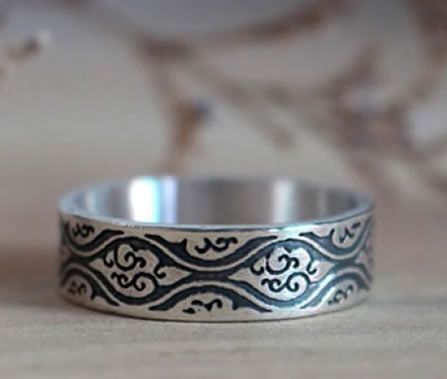
The term tachiwaki or tatewaku translates to "rising steam." It consists of two wavy lines representing steam ascending into the sky, creating a poetic image of movement and lightness. This motif, with its harmonious curves, symbolizes the constant flow of life and the way challenges, like steam, gently rise and dissipate. Sometimes, a cloud is depicted among these lines to form the pattern kumotatewaku, or chrysanthemums are added, resulting in kikutatewaku, which adds an extra layer of beauty and complexity to this artistic representation.
The design evokes the mist that can be seen over marshes, ponds, and streams in spring, a fine mist floating above the water, creating a serene and mysterious landscape. This morning mist, known as kiri in Japanese, is often associated with the cherry blossom season (sakura no kisetsu), a significant time in the Japanese calendar. The combination of mist and cherry blossoms reinforces the image of impermanence, fleeting beauty, and the perpetual cycle of nature. It is a nod to Buddhist philosophy, which is pervasive in Japanese culture and teaches that everything is transient.
As this motif involves complex and challenging embroidery, it was reserved for the kimonos of the Japanese elite as early as the Heian period (794-1185). Only the most skilled and experienced artisans could create this motif with the precision and delicacy required to render it as elegant and sophisticated. Tachiwaki kimonos were often worn by nobility and members of the imperial court, and this pattern became a symbol of high social status and artistic refinement. Additionally, the colors used in these motifs had their own symbolism: shades of blue, and gold often represented nobility and purity of spirit.
Just as steam rises slowly and surely into the sky, this motif symbolizes the elevation of the spirit and the ability to overcome adverse events. It is considered a good luck charm for those seeking to rise above and conquer adversity. The tachiwaki pattern embodies perseverance and resilience, reminding us that even in the most challenging times, it is possible to rise above difficulties and reach new heights.
Yagasuri: Straight as an Arrow
The traditional Japanese motif Yagasuri, also known as Yabane, originates from the Edo period (1603-1868), a time when Japanese arts and crafts reached remarkable levels of sophistication. This motif is inspired by the fletching of arrows used in Japanese archery (Kyūdō), where the vanes, often made from bird feathers, played a crucial role in the stability and precision of the arrows in flight.
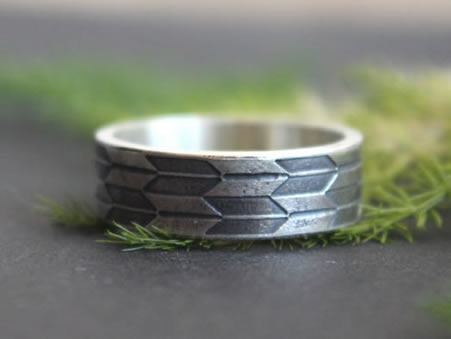
Originally, the Yagasuri motif was closely tied to martial practices, particularly among the samurai and warrior traditions. The arrow symbolized uprightness, irreversibility, and determination: once shot, it flies straight toward its target and cannot turn back. Over time, this symbolism expanded beyond the martial context to touch on more universal aspects of life, such as personal success and protection.
During the Meiji era (1868-1912), with Japan’s opening to the West and the modernization of traditions, the Yagasuri motif became more popular. It became a cherished ornament in women’s kimonos, especially those worn during weddings. This choice carried strong symbolism: just as the arrow shot never returns, the young bride was not expected to return to her parents’ home after marriage, signifying her commitment to her new life. The motif also expressed wishes for happiness and success, so that the couple would progress together toward their goals.
Simultaneously, Yagasuri gained significance as a spiritual protector. This is still evident today through Hamaya ("demon-chasing arrows"), lucky arrows sold during New Year celebrations. These ritual arrows are designed to ward off evil spirits and protect homes. Their connection to the Yagasuri motif strengthens the association of the latter with values of protection and good fortune.
Over time, Yagasuri also found its place in other important milestones of life, such as graduation ceremonies. It is often featured in the hakama (traditional trousers) worn by female students during graduation ceremonies. This association evokes wishes for success and progress in life, while recalling the metaphor of the arrow that never turns back.
Yagasuri remains deeply rooted in Japanese culture. Although it is now used in modern contexts, such as accessories, decorative items, or contemporary design products, it continues to carry universal messages of determination, protection, and aspiration for a better future.
To learn more about Japanese symbols, we recommend the following books:
Japanese wedding theme
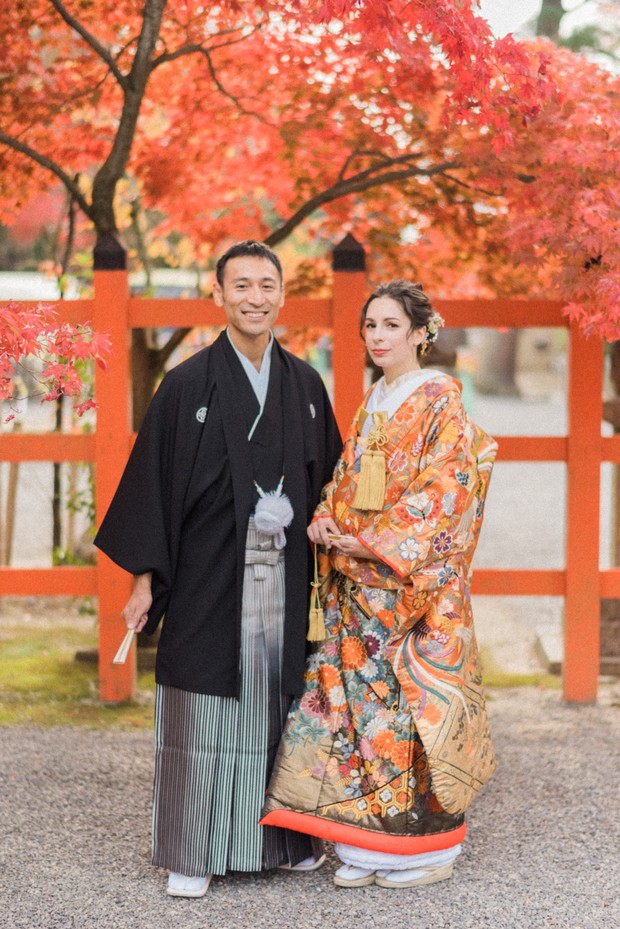
No matter your style, you will certainly find the perfect model for your Japanese wedding: chic, classy, understated, organized, zen, restful, refined, or elegant. Japanese weddings are a subtle fusion of tradition and modernity, harmoniously blending ancient symbolic elements with contemporary touches. This creates a unique and profoundly meaningful atmosphere to celebrate the union of two souls.
Preferred color tones for a Japanese-themed wedding are typically soft and soothing, such as pastels, including pink or purple. These delicate colors evoke the beauty of cherry blossoms, which symbolize the fleeting nature of life and the importance of cherishing every moment. Purple, on the other hand, is associated with nobility and spirituality in Japanese culture. If you prefer more vibrant hues, red is a prominent color in Japanese wedding ceremonies as it symbolizes luck, prosperity, and protection against evil spirits. Wearing red on your wedding day is a way to invite good fortune into the union and ensure a bright future for the couple.
The variety of colors allows you to personalize the ambiance of your wedding according to your vision. Whether you choose a calming pastel palette or vibrant colors, there is a wide range of options to create an atmosphere perfectly suited to Japanese aesthetics and the uniqueness of your celebration. The softness of pastels also reflects the refined simplicity of Japanese gardens, where each element is chosen to evoke a sense of peace and harmony.
To guide you in organizing your Japanese wedding, we leave you with some links to more specialized sites to give you ideas:
- Japanese Wedding Theme
- Japanese wedding themed ideas on pinterest
- Love In Blossom Japanese-Inspired Wedding
- Traditions | The Japanese Wedding
- Unique Wedding Ideas: Japanese Influenced Wedding Style, Inspiration + Ideas
- What to Expect at a Japanese Wedding
You now need to choose the design that best fits your wedding, a unique and unforgettable moment. If you haven’t found the symbol that makes your heart race in our catalog, we invite you to contact us to share your vision. We are here to collaborate with you to create a ring that embodies your love, personality, and cultural roots. Whether you wish to incorporate a traditional Japanese motif like the cherry blossom (sakura), the butterfly (cho), or the crane (tsuru), symbolizing longevity and happiness, we can customize every detail to make your ring unique.
We offer most rings in various widths and thicknesses to suit both the groom and the bride. However, if you require a different width for one of our models, please reach out to us to check if we can accommodate your customized request. We are here to provide you with a tailored experience where every detail is crafted to meet your expectations and desires.
You will find our various models on the theme of Japan listed below:
The cherry blossom
The cherry blossom, or "sakura," is much more than just a Japanese ring. It is a metaphor for life, beautiful and short, symbolizing renewal, success, evolution, and the hope associated with the new season.
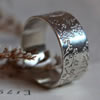
|
Sakura: sakura means “cherry blossom” in Japanese. This band is 10 mm wide and shows a low-relief cherry blossom pattern |
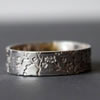
|
Misao: misao means “fidelity” in Japanese. This band is 6mm wide and shows a low-relif cherry blossom pattern. |
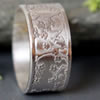
|
Misaki: misaki means “beautiful tree flower” in Japanese. The band is 10 mm wide and shows a high-relief cherry blossom pattern. |
The crane
The crane, this iconic Japanese bird, symbolizes much more than longevity, happiness, luck, and loyalty. It also embodies peace, prosperity, health, and wisdom.
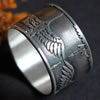
|
Legend of the thousand cranes: this ring refers to the Japanese legend and is 0.47 in (1.2 cm) wide. |
The koi fish
The koi carp, this strikingly beautiful Japanese fish, symbolizes much more than strength, bravery, perseverance, success, peace, serenity, love, and virility.
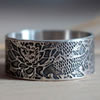
|
Carp in a lotus pond: this Japanese ring shows koi fish swimming among plants including lotuses. It is 10 mm wide |
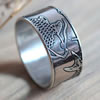
|
Koi: this fish ring is 10 mm wide. |
The sea
The sea, this vast ocean that surrounds Japan, is much more than a simple symbol. It is the cradle of life, an essential element of Japanese culture and history. The sea and the waves can symbolize calm or strength depending on the pattern.
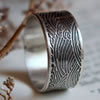
|
The sea: this Japanese pattern ring shows a raging sea to express nature’s strength compare to the fragility of humans. This ring is 10 mm wide. |
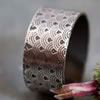
|
Hitomi: this Japanese pattern ring sows a wave pattern called Seigaiha. It symbolizes calm, peace, quiet strength and good fortune. This band is 10 mm wide. |
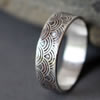
|
Hitomi petite: this ring is identical to te previous one but narrower for a width of 4mm. |
Origami
Origami, this ancient Japanese art of paper folding, is much more than a simple symbol of dexterity, patience, delicacy, discipline, and precision. It is also a symbol of creativity, ingenuity, and harmony.
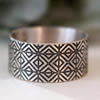
|
Origami: this Japanese ring with a geometric style evokes paper folding. It is 10 mm wide. |
The leaf of ginkgo biloba
The ginkgo biloba leaf, from the immortal tree, is much more than a simple symbol of longevity, unity, invariability, growth, prosperity, and tranquility. It is also a symbol of resilience and perseverance, as it is capable of surviving in extreme conditions and adapting to its environment. Its two-lobed leaf evokes duality, separation, reconciliation, and paradox. Its duality makes it a symbol of love. Additionally, the ginkgo biloba leaf is often associated with wisdom and knowledge.
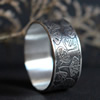
|
Ginkgo: this Japanese leaf ring is 10 mm wide. |
The rice
Rice, a staple food in Japan, is much more than a simple symbol of purity and wealth. It is also a symbol of fertility and prosperity, as it is associated with abundance and growth.
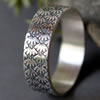
|
Ineko: the name of this ring means “small rice shoot”. It shows stylized rice stems in as botanical and countryside style. It is 6mm wide. |
The hemp leaf
The hemp leaf, also known as the asanoha pattern, is much more than a simple good luck charm to wish for good development and growth. It is also a symbol of resilience and strength, as it is known for its robustness and ability to withstand the elements.
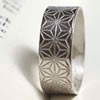
|
Asanoha: the name of this Japanese ring means "hemp leaf". It shows stylized, geometric, hemp flowers. It is 0.31 in (0.8 cm) wide. |
The turtle shell
The turtle shell, with its Kikkô pattern, is much more than a simple symbol of longevity and luck. It is also a symbol of protection and security, as it is known for its resistance and ability to protect the turtle from predators.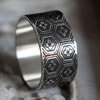
|
Kikkô: this ring shows hexagonal shapes depicting the turtle shell. The two-row pattern is 10 mm wide. |
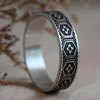
|
Kikko hanabishi: this ring shows hexagonal shapes depicting the turtle shell. The single line pattern is 6mm wide. |
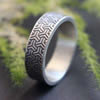
|
Bishamon Kikkou: This ring, 0.24 in (0.6 cm) wide, features a Y-shaped design composed of three interwoven turtle scales. |
Rise to the sky
The Tachiwaki motif, with its two wavy lines evoking steam rising to the sky, is much more than a simple symbol of perseverance and the ability to overcome adversity. It is also a symbol of transformation and growth, as it reminds us of humanity’s capacity to rise above difficulties and transform into a better version of itself.
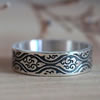
|
Tachiwaki: this ring is a variation of the classic pattern of wavy lines since it incorporates clouds in the center. It is 0.24 in (0.6 cm) wide. |
Straight as an Arrow
The Yagasuri motif, inspired by the fletching of arrows used in Japanese archery (Kyūdō), symbolizes determination, precision, and irreversibility. Traditionally associated with protection, it also appears during significant events such as weddings and graduations. The Yagasuri ring, engraved with this motif, becomes a modern talisman, bringing happiness and progress toward one’s goals.
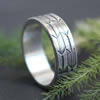
|
Yagasuri: This ring featuring arrow fletching lines is 0.24 in (0.6 cm) wide. |
To start your search for your Japanese wedding:

